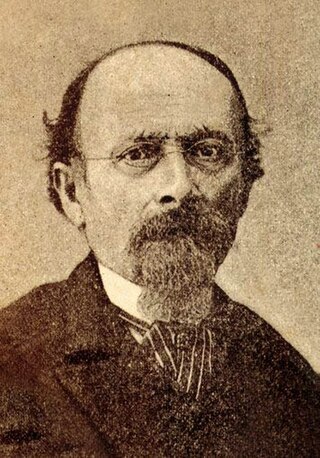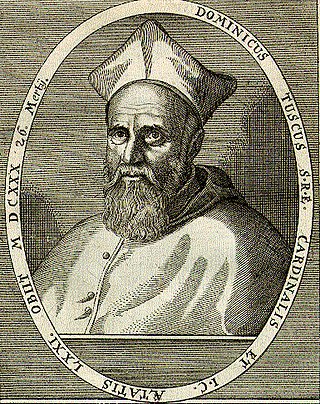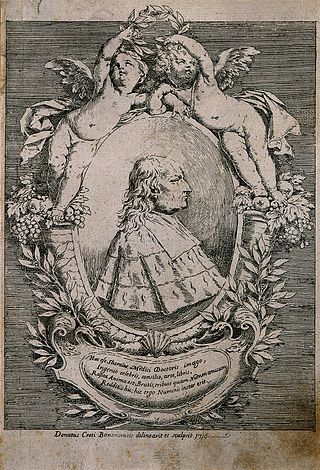Related Research Articles

BartolomeoBorghesi was an Italian antiquarian who was a key figure in establishing the science of numismatics.
Aldus Manutius, the Younger was the grandson of Aldus Manutius and son of Paulus Manutius. He was the last member of the Manuzio family to be active in the Aldine Press that his grandfather founded.

GiovanniDomenico Cassini, also known as Jean-Dominique Cassini was an Italian mathematician, astronomer and engineer. Cassini was born in Perinaldo, near Imperia, at that time in the County of Nice, part of the Savoyard state. Cassini is known for his work on astronomy and engineering. He discovered four satellites of the planet Saturn and noted the division of the rings of Saturn; the Cassini Division was named after him. Giovanni Domenico Cassini was also the first of his family to begin work on the project of creating a topographic map of France.
Giovanni Gioseffo dal Sole was an Italian painter and engraver from Bologna, active in the late-Baroque period. Upon the death of Carlo Cignani, Gioseffo dal Sole became among the most prominent painters in Bologna, described as the Guido Moderno.

Ercole Lelli was an Italian painter of the late-Baroque, active mainly in Northern Italy, including his native city of Bologna, as well as Padua and Piacenza.

Alfonso Michele Litta was an Italian nobleman who was a Cardinal and Archbishop of Milan from 1652 to 1679.

Pompeo Cesura, also known as Pompeo Dall'Aquila or Pompeo Aquilano, was an Italian painter and engraver. It is stated in the 'Abecedario Pittorico' by Orlandi to have been a painter of history, specializing both in oil and fresco. He flourished in the latter part of the 16th century. There is a painting by him in the church of Santo Spirito in Sassia in Rome, representing the Deposition, which was engraved by Orazio de Santis in 1572. Several frescoes by him can be viewed in his birthplace of L'Aquila, Abruzzo.

The Dizionario Biografico degli Italiani is a biographical dictionary published in 100 volumes by the Istituto dell'Enciclopedia Italiana, started in 1960 and completed in 2020. It includes about 40,000 biographies of distinguished Italians. The entries are signed by their authors and provide a rich bibliography.

Antonio Concioli was an Italian painter, mainly depicting sacred subjects in a Neoclassical style.
Bernardo Minozzi was an Italian painter, mainly of landscapes in a late Baroque style.

Giovanni Gabrielli was an Italian actor of the commedia dell'arte, who performed under the name Sivello.
Stefano Arteaga was a Spanish-born writer on theater and music, active in Italy.

Giovan Battista di Crollalanza was an Italian writer. From 1841 he published works on many topics and in several genres, among them histories, plays and poetry. From the 1870s he wrote only on heraldry.
Caio Domenico Gallo, was an Italian historian. Gallo was born and died in Messina, in the north-east of the Mediterranean island of Sicily. His principal work, the Annali della città di Messina, is a comprehensive history of that city from its beginnings up to the time of the plague of 1743. It was published in four volumes, of which only two appeared during his lifetime, in 1756 and 1758. The third volume was published posthumously in 1804, and the fourth in 1875. Two volumes of later history, by Gaetano Oliva, were added in 1896.

Pier or Pietro Jacopo Martello was an Italian poet, playwright and dramatic theorist.

Domenico Toschi was an Italian soldier, jurist, and cardinal of the Catholic Church.
The Palazzo Vizzani Lambertini Sanguinetti, sometimes known merely as Palazzo Vizzani, is a Renaissance palace located on Via Santo Stefano #43 in the center of Bologna, region of Emilia-Romagna, Italy. Presently the palace houses the faculty of Foreign Languages and Literature of the University of Bologna.

Giovanni Girolamo Sbaraglia was an Italian physician and writer. He was a determined, perhaps obsessed, critic of the famous anatomist Marcello Malpighi.

Alfredo De Marsico was an Italian Fascist politician who served as the last Minister of Justice of the Mussolini Cabinet from February to July 1943. After the war he continued his political career in the National Monarchist Party and later in the People's Monarchist Party.

The Accademia dei Gelati was a learned society of intellectuals, mainly noblemen, that significantly influenced the cultural and political life of Baroque Bologna. It is considered one of the most important 17th-century Italian academies.
References
- ↑ Scifoni, Felice (1849). Dizionario biografico universale. Vol. 5. Florence: Davide Passagli. p. 645.